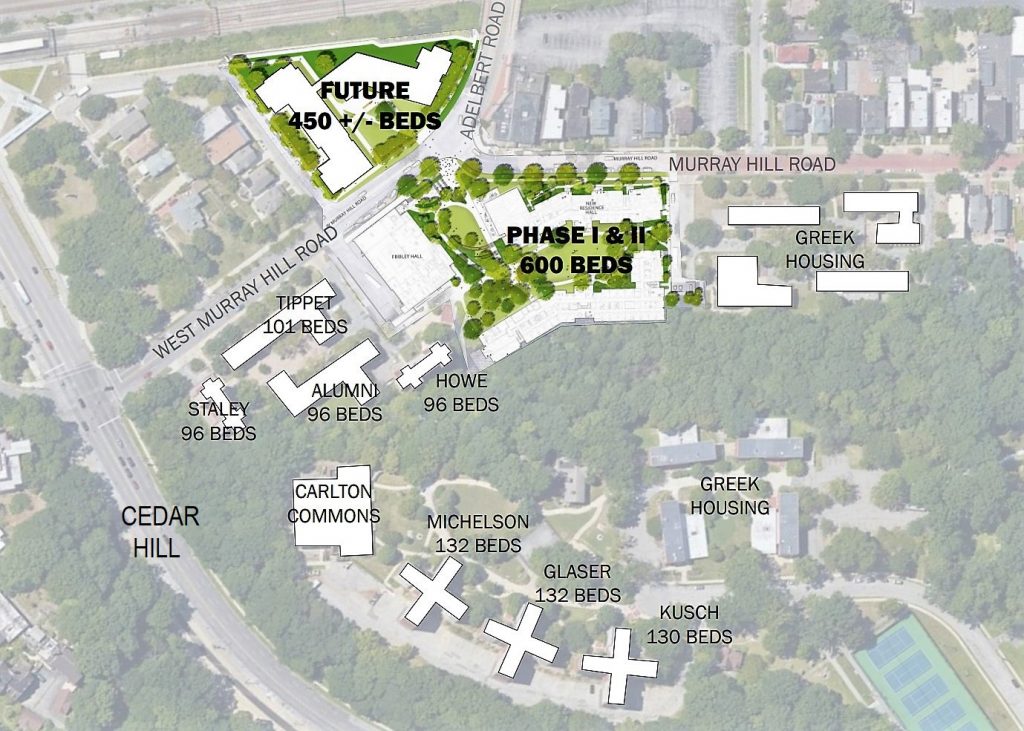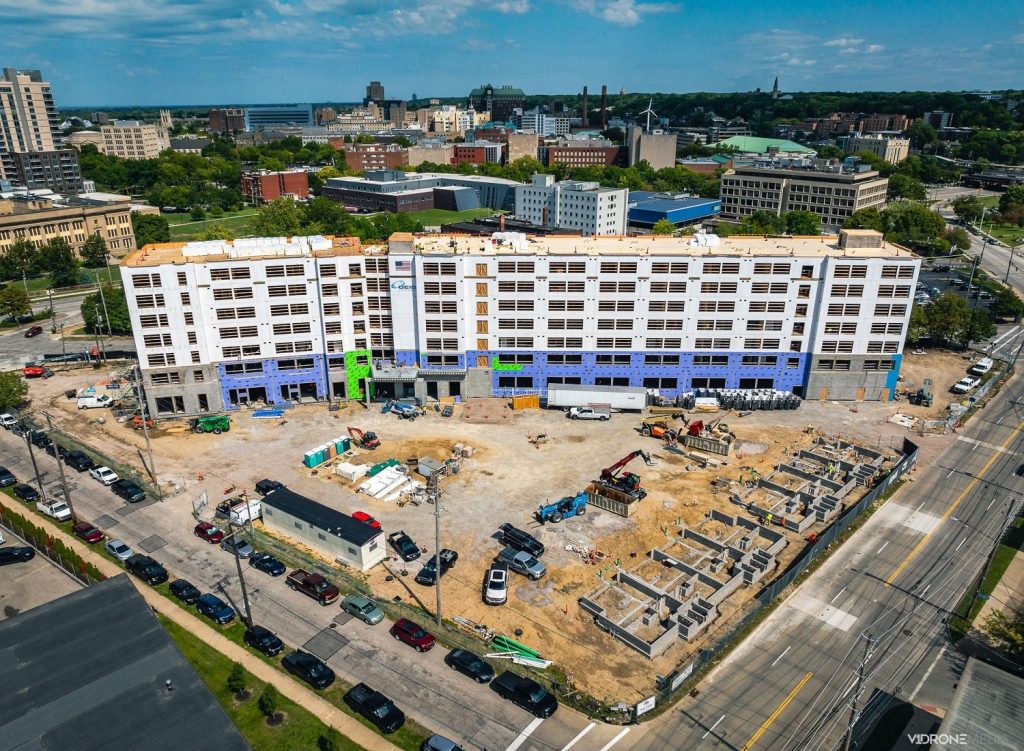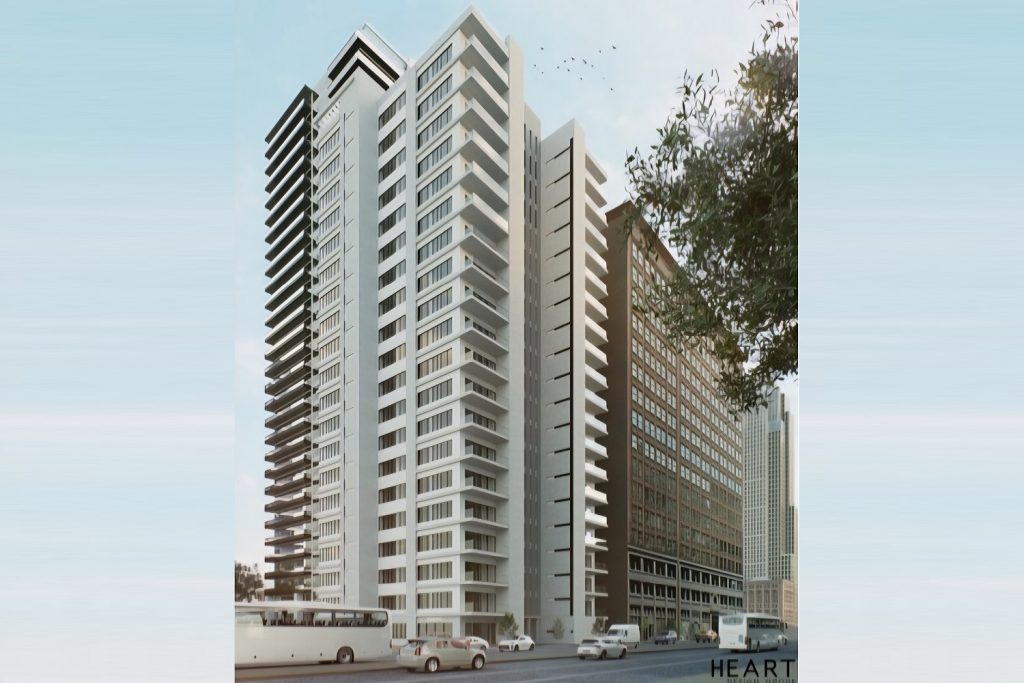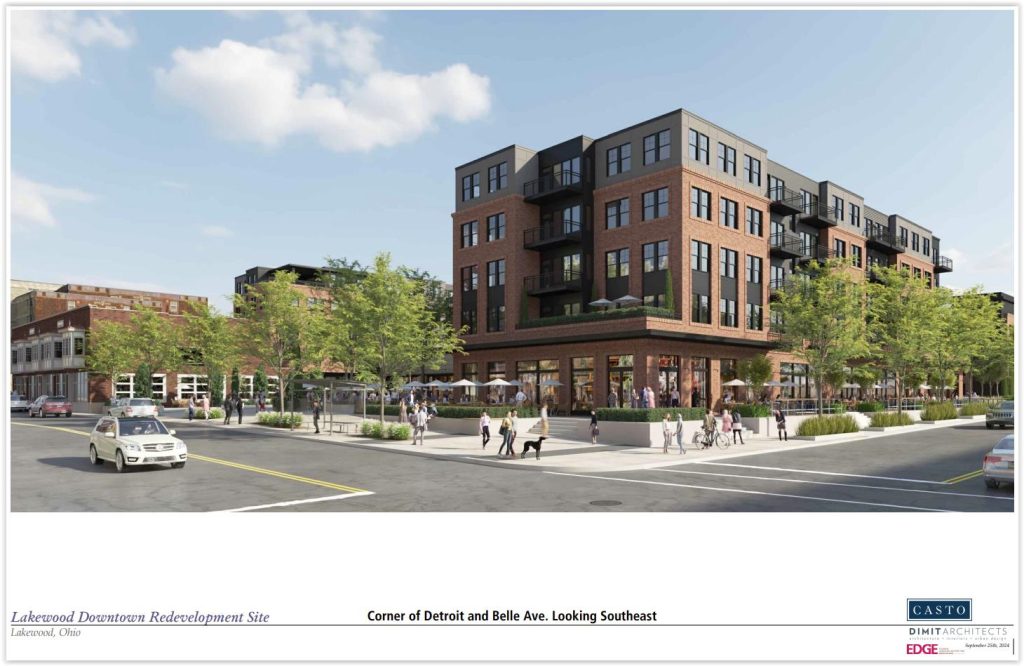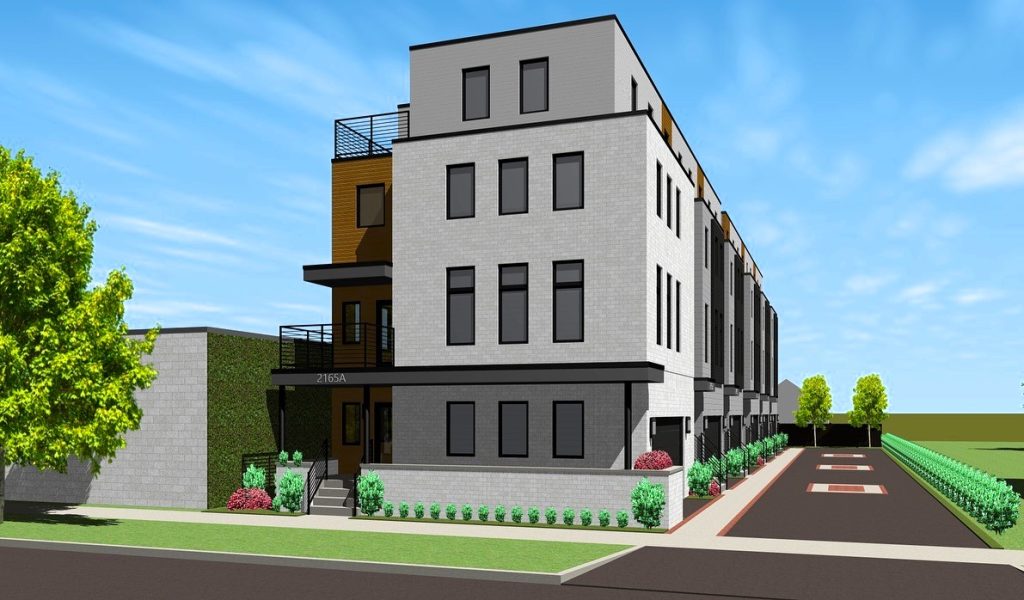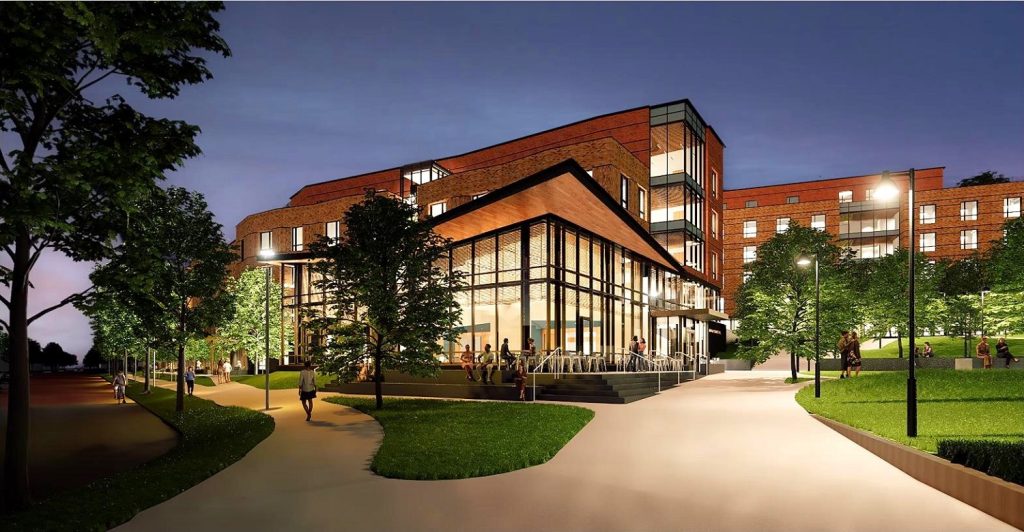
The first two phases of expanding Case Western Reserve University’s South Residential Village were completed in time for this Fall Semester. But they now appear to be the last phases, A third phase proposed across the street is not being pursued due to there being a sufficient amount of student housing (William Rawn Associates). CLICK IMAGES TO ENLARGE THEM.
Third phase no longer on drawing board
As Case Western Reserve University (CWRU) approaches its 200th anniversary, just two years away, the growing college has just one megaproject on its syllabus for Cleveland’s University Circle — the $300 million Interdisciplinary Science and Engineering Building. So CWRU’s bicentennial legacy is to do what it has often done — prudently build when it needs to, not when it wants to. Even so, news of what the university is not building may come as a surprise.
CWRU has put on indefinite hold the construction of the third phase of its South Residential Village expansion. Phases one and two took the forms of two new residence halls — a 139,100-square-foot, six-story Hill Building below the wooded Cedar Hill and a 56,900-square-foot, four-story Murray Building next to Murray Hill Road. Together they added 600 beds for undergraduates starting this fall semester.
Phase three was planned to add another 450 beds in a new dorm to be built on Parking Lot 44, across the intersection of Murray Hill and Adelbert roads from the first two phases. The site is next to the Greater Cleveland Regional Transit Authority’s Cedar-University Red Line rail station. A CWRU spokesperson confirmed the third phase is no longer planned, saying it isn’t needed though he didn’t elaborate.
When plans were submitted to the city in 2022 for the first two phases, CWRU Director of University Housing John White told a city design review panel that pursuit of the third phase would be based on student enrollment growth. Also, construction of the first two phases cost the university $110 million — quite a bit more than the $72 million it planned to spend before the pandemic put those plans on hold for three years.
The university develops enrollment projections but it does not share them publicly, leaving everyone else to speculate on what the halt in the South Residential expansion means. Although CWRU’s enrollment continues to grow, it isn’t growing as fast as it was prior to the pandemic that began in early 2020, according to historical university data.
Total enrollment — undergraduates plus graduates — grew 15.8 percent, from 10,771 students to 12,475 in the decade from 2014-24. Breaking that down further, total enrollment grew 10.2 percent in the five years from 2014-19, while rising just over 5 percent from 2019-24.
But the South Residential Village expansion is intended to house mostly undergraduate students — and that’s where the university’s real growth in enrollment has been. Undergrad enrollment has shot up 33 percent from 2014-24, with 4,911 students enrolled in 2014 compared to 6,528 in 2024. And, it is growing even faster now compared to before the pandemic. It rose 9.6 percent from 2014-19 and 21.2 percent from 2019-24.
All first- and second-year undergraduate students are required to live on-campus unless they choose to live with their parents within 40 miles of the campus. Meanwhile, CWRU’s Office of University Housing does not offer an on-campus graduate student housing program. However, the housing office does provide resources to graduate students to find housing.
CWRU has been accommodating the growth in the number of students by means other than building new residence halls. One is through the private sector. As new buildings are privately built, student populations are shifted around with graduate students moved off-campus to private-sector-owned properties. Undergrads fill the voids left behind on campus.
Numerous apartments in old houses, renovated buildings and new buildings are being provided in neighborhoods within and near CWRU’s University Circle campus. Those include Little Italy, Cleveland Heights’ Cedar-Fairmount, Hough, Fairfax, Glenville’s Circle North and East Cleveland’s Circle East.
A large new building that may suit students’ needs is under construction. The Skyline On Stokes Apartments is due to open early next year in the 2100 block of Stokes Boulevard in University Circle. Two-thirds of its 261 units will be furnished studios and be affordable to those earning 80 percent of the area’s median income.
The university has leased space in some new developments. When the new Monroe Apartments in Little Italy opened, CWRU leased all 80 units for staff and students. In Cleveland Heights, atop Cedar Hill from the campus, Integrity Realty Group’s 58-unit boarding house also helped provide housing relief to CWRU. So did the Euclid3 — a trio of buildings on Euclid Avenue, spanning the block between East 115th and East 116th streets.
Nearby, also at the top of Cedar Hill, CWRU’s South Quad is comprised of multiple residence halls and Greek housing — fraternities and sororities. In the university’s long-range plans, it showed the South Quad could be demolished someday for recreational spaces or to sell off for future development. The expansion of the South Residential Village would have allowed that to happen. Instead, the university increased its holdings near the South Quad.
This past summer, city records show CWRU spent more than $600,000 to convert the former McGregor At Overlook nursing home, 2187 Overlook Rd. bordering Cleveland Heights and Cleveland, into the Overlook House with 25 housing units for upperclassmen. The university bought the property in April 2023 for $1,575,000, according to Cuyahoga County property records.
Two years earlier, and to accommodate more upperclassmen, county records show CWRU paid $1.26 million for a 29-unit, 120-year-old apartment building at 1716 E. 115th St. in University Circle. It’s next to the multiple-building Uptown Apartments with ground-floor retailers on both sides of Euclid, in a bustling, diverse neighborhood.
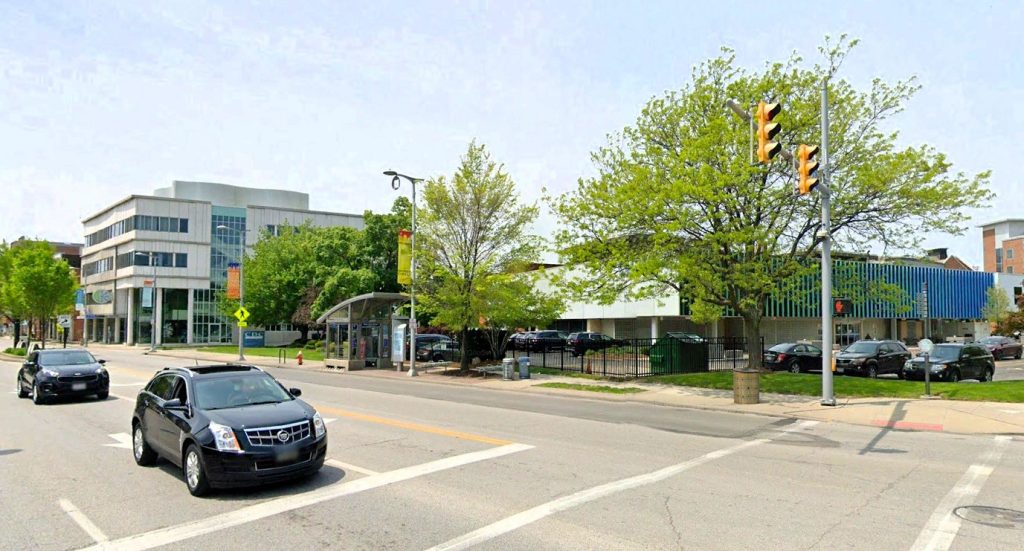
The building above the cars, formerly the Cleveland Hearing and Speech Center, was bought by Case Western Reserve University for offices and classrooms. The university also owns the former Center for Dialysis Care at right but hasn’t revealed its intentions for that site. Five years ago, an 11-story apartment building was planned here (Google).
At the east end of this district, in September 2022, CWRU paid $3.75 million for the 1.9-acre former Center for Dialysis Care, 11717 Euclid, that was previously owned by University Circle Inc. UCI sought out developers or other new users for the property which has a large parking lot.
A CWRU spokesperson said the 38,000-square-foot, 61-year-old building is mostly vacant but a portion is used by the university for storage. Its parking area, called the Euclid 118 Lot, is for CWRU parking by permit only. There are no other plans for this property but, in the past, it was sought after by the Finch Group for its 11-story Infinium development.
Another residential development is still lurking in the background. An engineer for WXZ Development Inc. of Fairview Park filed plans with the city in May and additional documents earlier this month to deliver 52 apartments and multiple retail spaces among two buildings — an historic structure called the Monmouth Building and a new building up to nine stories high, both at 11619 Euclid Ave.
Between the dialysis center and the Monmouth, CWRU bought in August 2023 the entire four-story Cleveland Hearing and Speech Center, 11635 Euclid, for $700,000, county records show. Previously the university owned only the third floor for the College of Arts and Sciences (CAS). It also leased half of the fourth floor for CAS, the university spokesperson said.
CAS departments will now be housed in floors one through three, including minor reconfigurations on the second floor to accommodate that, he added. Early next year, work still to be defined will start on reconfiguring the fourth floor for some university relations and development functions.
END


